Charles Dickens was born in 1812 at Portsmouth and was one of the first world superstars both in his own lifetime and ever since. He was recognised not only in Great Britain as a great writer but abroad, particularly France and the United States where he travelled extensively. He emerged as a writer in a stratospheric way in 1836, with Pickwick Papers and Oliver Twist.
The canvas for Charles Dickens and his inspiration was undoubtedly London, through its people, their characters and social problems of the time. London’s population had already exceeded one million people when Charles Dickens was born. His books are infused with references to London buildings and locations. Whilst much is altered in London since his passing in 1870, there are some localities where he lived and walked that are little changed. A tour with a Blue Badge Tourist Guide will help you discover Charles Dickens and these top ten facts may “wet” your appetite for a cultural take on Charles Dickens London in its 19th-century Victorian guise.
1. Charles Dickens Museum in London
48 Doughty Street is such a good place to start for any Charles Dickens fan and is located in the “Georgian” district of Camden an area built during the mid-1700s to early 1800s. The locality is pretty much as Dickens would remember it if he was to return today. Construction of the southern end of the street began in 1790 and the whole locality is an architectural gem. Dickens was 25 when he rented the house in 1837 at £80 a year to accommodate his newly created and expanding family. He now had a wife, his first child, and a confidence that he could live as a gentleman.
His career was taking off, Charles Dickens was socially moving up rapidly, and he needed a base to write in some comfort. He took a lease on a 12 room house with four floors and a basement. It was converted into a museum in 1925. There were a number of dramatic events here including the sudden death of his wife’s young sister 17-year-old Mary who was adored by Charles Dickens. She was part of the household in 1837. This profoundly shocked him and for the only time in his life, he stopped work. See his writing desk and chair which was the inspiration for Van Gogh’s “post-impressionist” painting “The Chair” which can be seen at the nearby National Gallery in Trafalgar Square.
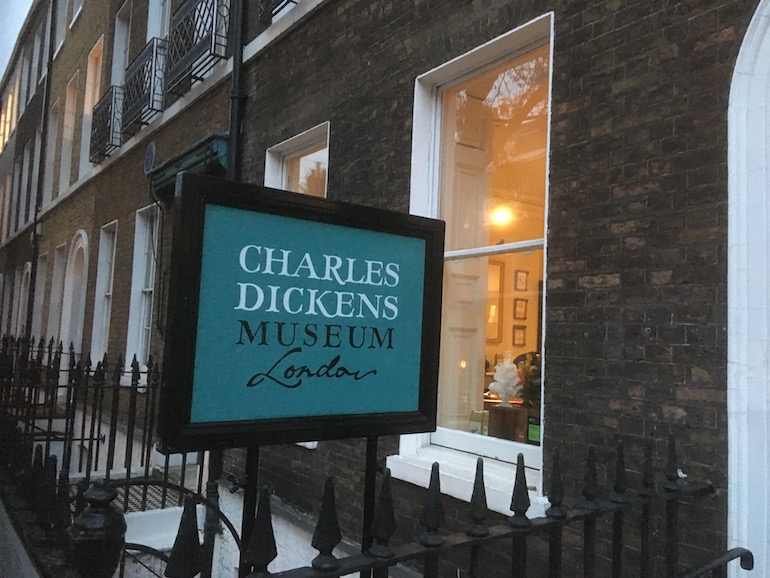 Charles Dickens Museum London. Photo Credit: © Edwin Lerner.
Charles Dickens Museum London. Photo Credit: © Edwin Lerner.
2. Walking With Charles Dickens
Take a walk with a Blue Badge Tourist Guide in the steps of Dickens and re-imagine Victorian London and its social conditions in Clerkenwell and the old City of London. Dickens was a 19th Century social observer and saw first hand what London was experiencing via rapid urbanisation and consequent growing pains. Increasing immigration derived from dispossessed British rural agricultural workers because of industrialisation and the periodic influx of foreign immigrants (Italians, Irish, Jewish, to mention a few) seeking work. This tableau would become the backdrop to his earliest novels.
By 1835, Charles Dickens lived in the London sub-district of Holborn and was becoming independent of immediate family. Holborn then as now is a small locality, adjacent to a district called Clerkenwell, at that time one of the worst affected, notorious slums, and overcrowded parts of London. Clerkenwell with much of its historic building and street pattern still intact today, was in 1835 dangerous, poverty-stricken, crime-ridden, with gambling dens, petty pickpocketing, child stripping, robbery, prostitution and worse.
Slum housing filled every available space, quickly thrown up to provide shelter without proper sanitation, lighting and running water. No public health system existed to provide healthcare, there were no urban planning rules and no proper security. Modern policing was in its infancy and introduced in 1829.
Dickens walked during his writing career both for exercise, writing inspiration, and usually daily, and often during evening time to clear his head.
Charles Dickens had regular 12-mile walks and would think as he did so and mull over plot lines etc. Characters depicted in early books are taken from the backdrop of local London and were those observed in the immediate localities such as Clerkenwell. The Artful Dodger, Fagin, Oliver Twist, Sam Weller, Mr Pickwick, were devised from careful observation. The early books are littered with references to these places.
Dickens had visited the inside of prisons like Newgate Prison today the criminal law court known as The Old Bailey. Seeing inmates gained valuable insights as to why they were incarcerated. He was friendly with prison Governors as a journalist and saw local everyday London street life first hand. It was not all bad by any means but he could see the serious problems. You too with a qualified Blue Badge Tourist Guide can reimagine these events as you walk some of these same streets and alleyways.
3. Charles Dickens Early Life
Charles Dickens’ early life was shaped by family circumstances and a father, John Dickens, who was frequently in debt and living beyond his means, and who believed he had an entitlement to live like a gentleman. Charles was a not a dreamer, but clever, sensitive, intelligent, able through his genius and very hard work, to develop his writing talent despite an unreliable father.
John Dickens at one time became imprisoned In the Marshalsea Debtor’s Prison in Southwark for debt when Charles was only twelve. It introduced Charles Dickens to the implications of poverty, insecurity, and being forced to work in a menial and humiliating capacity at a blacking factory. He had until then aspirations of a good education and ambition to be successful. The family had to move continually from one London location to another to stay ahead of creditors. Dickens lived mainly with his mother, father, brothers and sisters until twenty-two. Charles Dickens was developing a writing career and abilities in the early years and first worked as a teenage office boy at Grays Inn for a firm of lawyers.
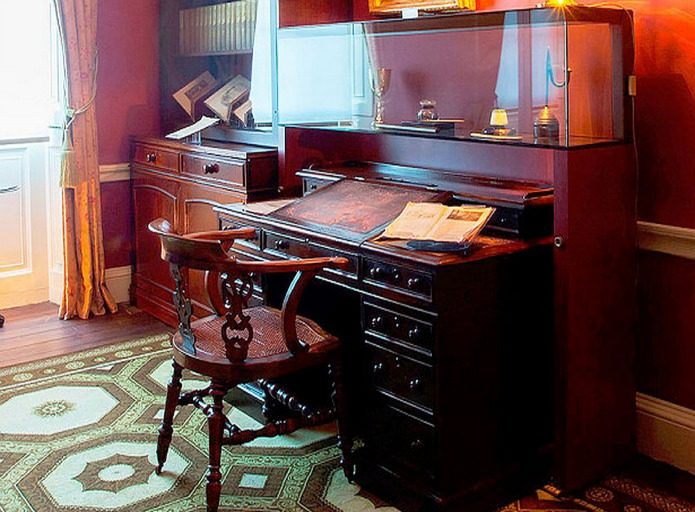 Charles Dickens Desk & Chair at the Charles Dickens Museum in London. Photo Credit: © Charles Dickens Museum.
Charles Dickens Desk & Chair at the Charles Dickens Museum in London. Photo Credit: © Charles Dickens Museum.
4. Charles Dickens Family Life
Charles Dickens was notable as a flamboyant dresser and a man who loved his family, and happy at least in the early years to be in its bosom. His younger brother Fred took a room in Dickens’s first apartment. This was at Furnival Inn, Holborn in 1835 costing £35 per year! It is also where a Dickens memorial now stands and is only steps away from some of the locations that inspired his early novels such as Oliver Twist.
As Dickens writing fame and wealth grew, his friendships became increasingly stellar until there were very few doors not open to him. You can see the site of the house he next leased after Doughty Street, which was more imposing befitting his greatly enhanced social status. This was at No 1 Devonshire Terrace, a larger residence at the north end of Marylebone High Street. The cost to him in 1840 was £160 a year and £800 upfront for a 12-year lease. The residence was demolished many years ago and a plaque to commemorate Dickens’s presence there is all that remains. Many famous friends in later years were entertained here. It is clear that he dominated his own household from the outset, even more so here, deciding everything. His wife was temperamentally “polar” opposite to her husband with little opportunity or inclination to express her own opinions. She was home-loving, happy in domestic duties.
Charles Dickens from the first seems to have chosen a wife quickly after early rejection from another young woman whose father was in banking. Charles sought security and comfort in a compliant Catherine as she was from a respectable family of a higher social station. Her father was Scottish in publishing and located on Fulham Road. This part of town is now part of upmarket Chelsea and Kensington. Catherine’s father liked Dickens, recognised his talent early on when the two met to discuss writing projects. However, in later times Dickens not only treated Catherine harshly but also some of her family.
Charles Dickens also did a great deal of good for many people in his lifetime. Nevertheless, he came in for criticism for ultimately “abandoning” his wife who was blameless. He substituted her for another much younger woman and actress- Ellen Ternan, an 18-year-old when they first met. He secretly funded a house for her in a little-known suburb in south London called Nunhead near Peckham Rye. His family and friends tried all in their power to protect his reputation when he separated from Catherine.
5. A Pillar Of Social Reform
Charles Dickens involvements, influence, were many and varied, using a writing platform to raise awareness of the many social evils of the time. He was in due course part owner of a widely read weekly magazine called Household Words editing and often publishing articles, and later a 100% owned publication All The Year Round. He took issue with poverty and how it was dealt with by consigning people into Poor Houses. He also realised that education was badly served in some cases (where it existed at all), through a few horrific private schools where unwanted children were consigned. Dickens was somewhat critical of Charterhouse school in Clerkenwell who had educated another giant literary figure, William Makepiece Thackery. The old Charterhouse school buildings still stand today although the school itself was relocated to Godalming long ago. The original Clerkenwell school site can be visited and is open to the public.
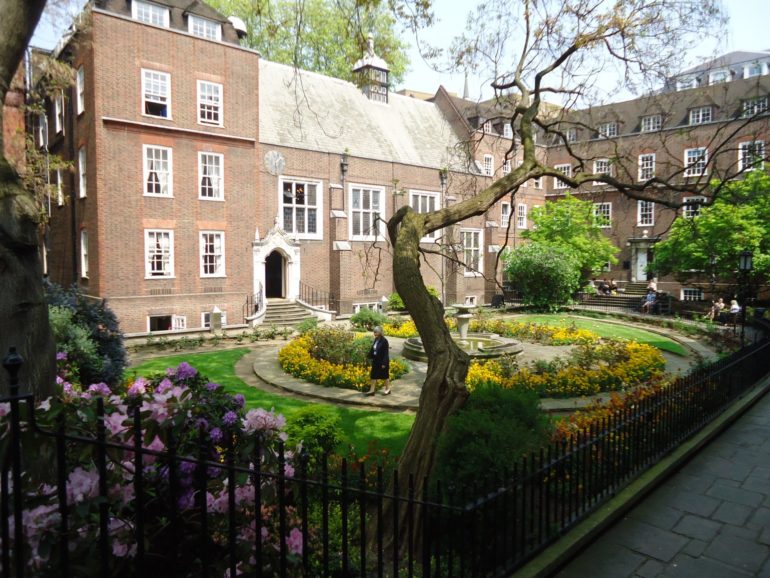 Staple Inn makes an appearance in the Charles Dickens novel. Photo Credit: ©Mark King.
Staple Inn makes an appearance in the Charles Dickens novel. Photo Credit: ©Mark King.
6. Charles Dickens and Royalty
Charles Dickens the writer rose in the mid-1800’s like no other, and ultimately was asked to entertain the reigning monarch, Queen Victoria. As an excellent mimic he was a natural performer and toured the country and abroad for public readings of his work and also gave theatrical performances for Queen Victoria at The Duke of Devonshire’s London residence from a play written by a friend Not So Bad As We Seem in 1850, and later again around 1856, a play called The Frozen Deep in a Regent Street building. The Queen had asked that he perform it at Buckingham Place. She was very amused on both occasions!
7. His Love Affair With The Countryside
Let your Blue Badge Tourist Guide show you another aspect of Dickens, his out of town life – Rochester and surrounding locality. This is about 30 miles from London. In later life, Charles Dickens moved to Kent and Gads Hill. This was a place to escape from London. It was here he was to die eventually. It is close to Rochester with which he is closely associated. In those days, Gads Hill was a quiet and tranquil location and he was able to continue the practice of his walks but this time in the woods, country lanes, and beautiful surrounding countryside. If you know where to look his associations with various places close to Gads Hill are there to be found. One of his best and final novels, Great Expectations, is rooted in this location.
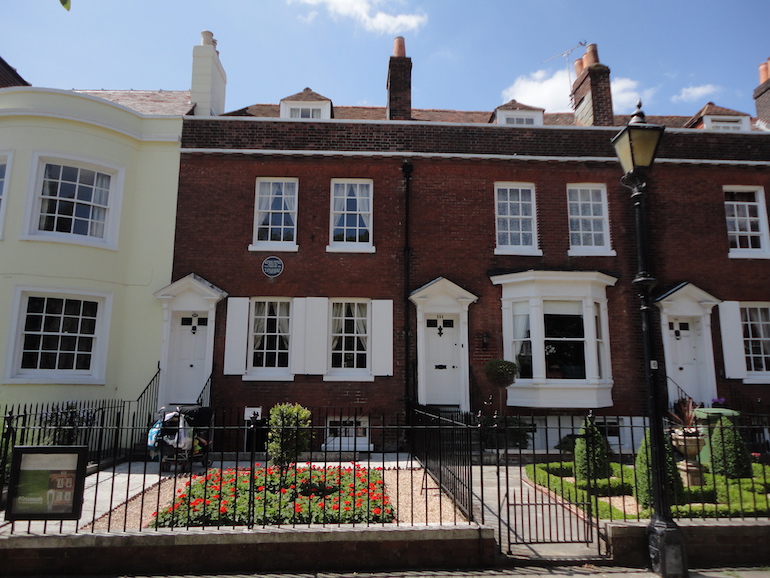 Charles Dickens’s birthplace, 393 Commercial Road, Portsmouth. Photo Credit: © Austriantraveler via Wikimedia Commons.
Charles Dickens’s birthplace, 393 Commercial Road, Portsmouth. Photo Credit: © Austriantraveler via Wikimedia Commons.
8. Charles Dickens Characters Inspired By Real People
The character of Fagin in Oliver Twist was based on a real-life criminal called Issac Ikey Soloman who had an amazing and famous criminal career living to tell the tale but dying in Hobart New Zealand. He used to operate on the borders of Holborn and Clerkenwell as a receiver of stolen goods (today this would be called “a fence”). He was imprisoned in Newgate Prison (more than once) before making an escape and the true story would make an excellent film in the same vein as Fagin?
9. Charles Dickens Death
Dickens died in 1870. Arrangements had been made for a local burial in the nearby village church of St Peter & St Paul, Shorne. However public demand via The Times newspaper resulted in the Dean of Westminster Abbey consenting to a burial there, which was done quickly and privately with only immediate family with neither his wife (not invited) or his mistress present in the South Transept or Poets Corner. His grave is not far from his friend the heiress and philanthropist Angela Burdett Coutts who he had been so closely connected with when she financed social projects and parts of his charitable work.
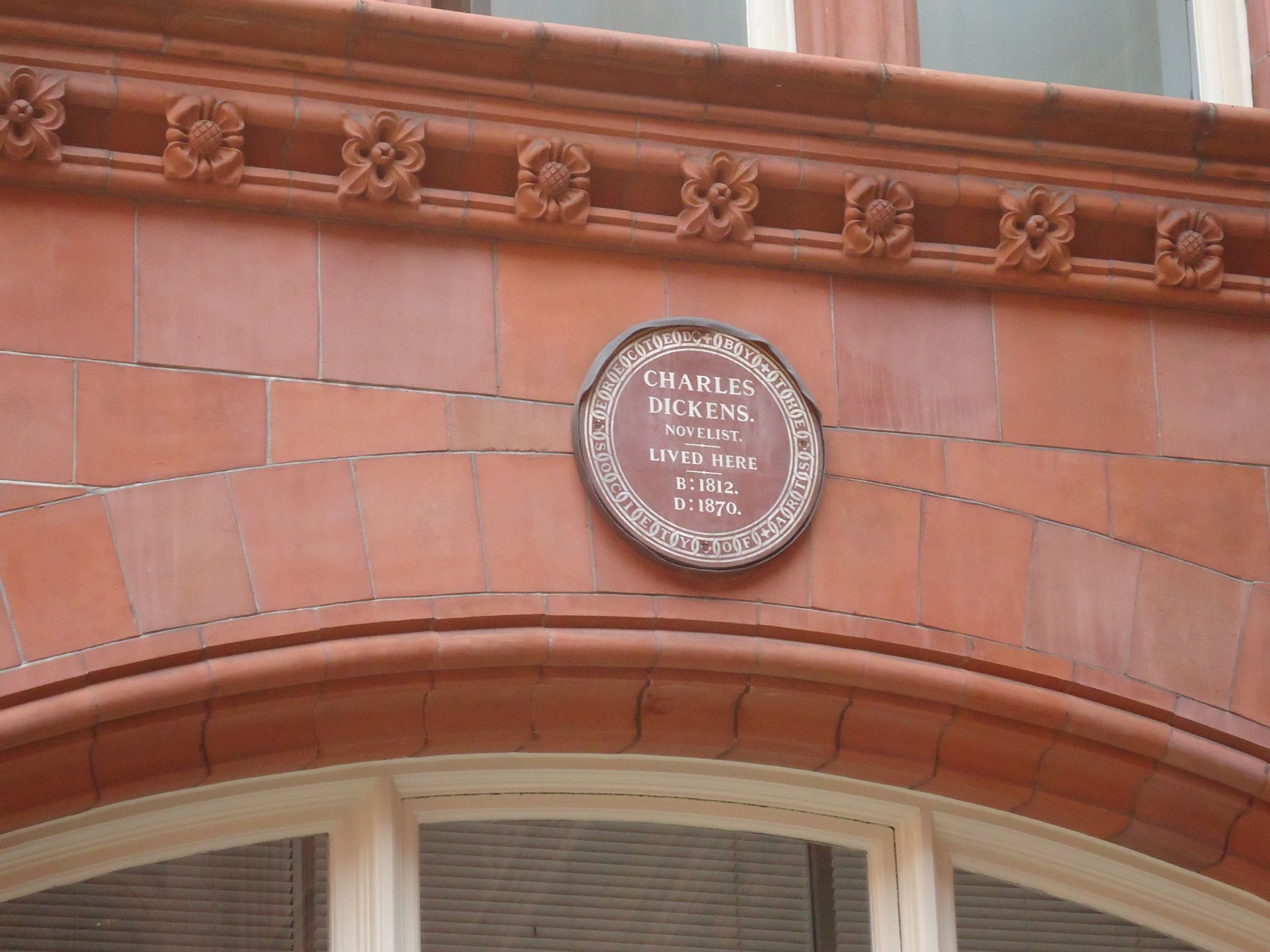 Charles Dickens: Assurance Building plaque for Dickens erected by the Royal Society of Arts. Photo Credit: ©Mark King.
Charles Dickens: Assurance Building plaque for Dickens erected by the Royal Society of Arts. Photo Credit: ©Mark King.
10. Films, Plays, TV Productions Inspired by Charles Dickens
There have been so many over the years, but perhaps none so entertaining as the 1968 musical film version of Oliver staring Ron Moody as Fagin and Oliver Reed as Bill Sikes. Lionel Bart wrote the music and lyrics and the film was made in Shepperton, England film Studio’s that still operates today. Oliver Reed’s uncle Carol Reed directed the film. There have been many film versions of a Christmas Carol depicting Scrooge. Michael Caine did a version with the Muppets, and of course, there was a musical version with Albert Finney. Great Expectations was made into a memorable film with Sir Alex Guinness starring as “Herbert Pocket” and Sir John Mills as “Pip”
We can safely say there are no finer guides than Blue Badge Tourist Guides to conduct you on well planned London and further afield tours for Dickens related sightseeing, to provide that intimate and knowledgeable insight into this literary legend and Victorian London.
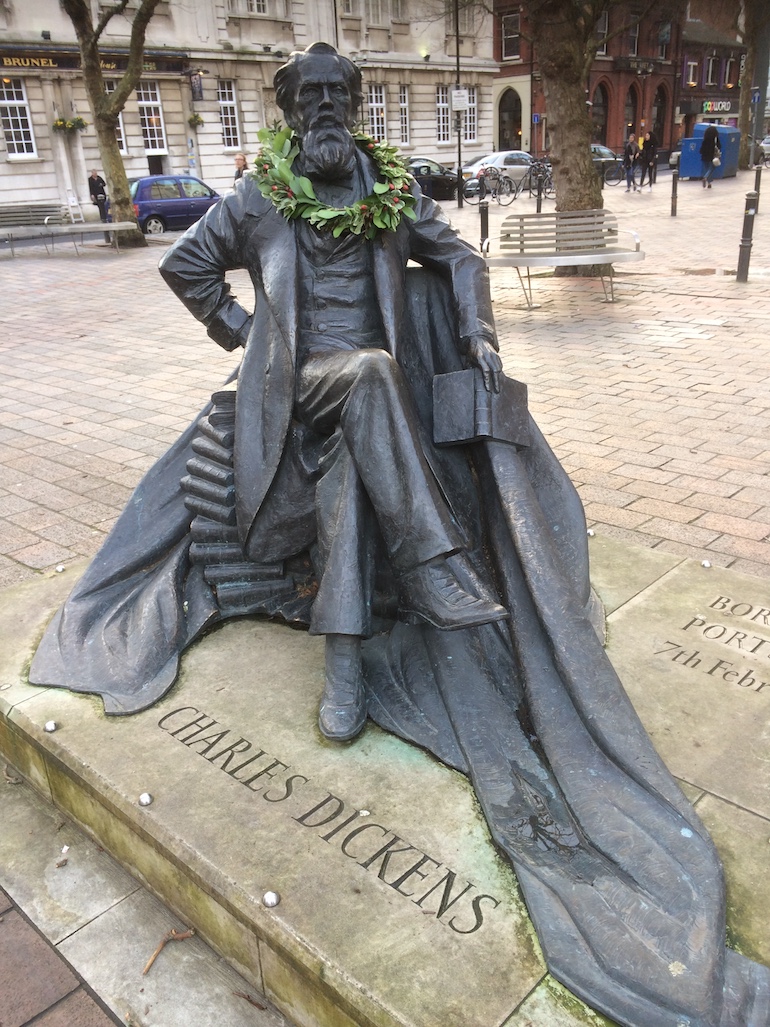 Charles Dickens Statue in Portsmouth. Photo Credit: © Edwin Lerner.
Charles Dickens Statue in Portsmouth. Photo Credit: © Edwin Lerner.



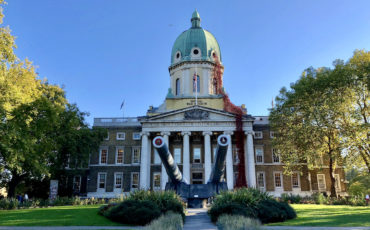
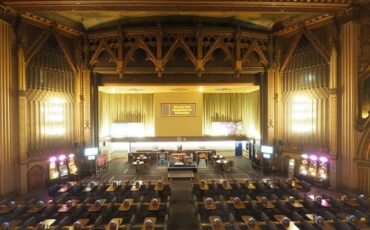


Leave a Reply